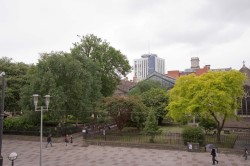 The provision of green space in urban areas can make a positive contribution to improving the quality of the urban landscape. Landscape quality can encompass many elements including environmental pollution and cleanliness, visual and aesthetic quality and perception of personal security.
The provision of green space in urban areas can make a positive contribution to improving the quality of the urban landscape. Landscape quality can encompass many elements including environmental pollution and cleanliness, visual and aesthetic quality and perception of personal security.
As urban areas become increasingly developed there is the need to implement and manage green space in order to contribute to a town or city’s image. A pleasant and well-maintained environment can attract companies to an area which can in turn attract visitors and improve people’s enjoyment of an area. The economic benefits of improved landscape quality from green space provision can be quantified through increased house prices, investment and land value.
The economic value of improved aesthetics and landscape quality in monetary terms can be estimated through people’s ‘willingness to pay’ for goods and services in an area, however there is weakness in this approach as this gives little insight into the combined value of more than one improvement.
Also, across England there is an ongoing struggle to find capital funding for investment in green infrastructure and also to find funding to maintain these areas to a high standard. Areas of green space that are not sufficiently maintained will fall into disrepair and attract acts of vandalism and graffiti.
It is important to:
Benefits of green infrastructure case studies:
Forest Research has developed Methuselah: A Monitoring and evaluation strategy for Greenspace (PDF-870K) as a monitoring and evaluation strategy for the provision of green space.